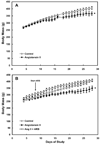Angiotensin II-induced reduction in body mass is Ang II receptor mediated in association with elevated corticosterone
- PMID: 20483644
- PMCID: PMC2918720
- DOI: 10.1016/j.ghir.2010.03.003
Angiotensin II-induced reduction in body mass is Ang II receptor mediated in association with elevated corticosterone
Abstract
The mechanisms by which elevated glucocorticoids contribute to decreased body mass via angiotensin II (Ang II) infusion are not completely described. This study addressed the hypothesis that chronic Ang II infusion suppresses hepatic growth hormone receptor (GHr) and IGF1 expressions via an Ang II receptor (AT1)-mediated pathway associated with elevated glucocorticoids. Sprague-Dawley rats were assigned to three groups: 1) Control, 2) Ang II-infused (80 ng/min x 28d) and 3) Ang II+angiotensin receptor blocker (ARB; 10 mg losartan/kg/d x 21d). After 28d, Ang II decreased body mass by 14% (407+/-8 vs 350+/-17 g) and hepatic AT1a, GHr, and IGF1 mRNA expressions by 45%, 44%, and 44%, respectively. ARB treatment completely prevented the loss in body mass (409+/-9 g) and AT1a and GHr expressions and partially recovered the loss of hepatic IGF1. Ang II increased plasma corticosterone (B) 3-fold (173+/-28 vs 555+/-42 ng/mL) and ARB treatment prevented the response (150+/-47 ng/mL). Food consumption did not change suggesting that the decrease in body mass resulted from the catabolic actions of the Ang II-induced increase in systemic B and not from reduced caloric intake. The prevention by ARB treatment of the Ang II-induced decrease in body mass and downregulation of AT1a, GHr and IGF1 coinciding with suppression of plasma B suggests that the Ang II-induced decrease in body mass is AT1 receptor mediated in conjunction with elevated B. These data suggest that alleviating the Ang II-induced cachexia requires targeting AT1 and suppressing glucocorticoid secretion.
Copyright 2010 Growth Hormone Research Society. Published by Elsevier Ltd. All rights reserved.
Conflict of interest statement
DISCLOSURE STATEMENT: The authors have nothing to disclose or any conflicts of interests.
Figures





Similar articles
-
Regulation of angiotensin II type 1 receptor mRNA and protein in angiotensin II-induced hypertension.Hypertension. 1999 Jan;33(1 Pt 2):340-6. doi: 10.1161/01.hyp.33.1.340. Hypertension. 1999. PMID: 9931127
-
Postnatal hypoxemia increases angiotensin II sensitivity and up-regulates AT1a angiotensin receptors in rat carotid body chemoreceptors.J Endocrinol. 2002 May;173(2):305-13. doi: 10.1677/joe.0.1730305. J Endocrinol. 2002. PMID: 12010638
-
AT1 receptor mediated augmentation of intrarenal angiotensinogen in angiotensin II-dependent hypertension.Hypertension. 2004 May;43(5):1126-32. doi: 10.1161/01.HYP.0000122875.91100.28. Epub 2004 Mar 22. Hypertension. 2004. PMID: 15037565 Free PMC article.
-
Receptor-mediated intrarenal angiotensin II augmentation in angiotensin II-infused rats.Hypertension. 1996 Oct;28(4):669-77. doi: 10.1161/01.hyp.28.4.669. Hypertension. 1996. PMID: 8843896
-
Renal and vascular injury induced by exogenous angiotensin II is AT1 receptor-dependent.Nephron. 2001 Jan;87(1):66-74. doi: 10.1159/000045886. Nephron. 2001. PMID: 11174028
Cited by
-
1-Sarcosine-angiotensin II infusion effects on food intake, weight loss, energy expenditure, and skeletal muscle UCP3 gene expression in a rat model.J Cachexia Sarcopenia Muscle. 2014 Sep;5(3):239-46. doi: 10.1007/s13539-014-0133-2. Epub 2014 Mar 11. J Cachexia Sarcopenia Muscle. 2014. PMID: 24614996 Free PMC article.
-
Salt-Sensitive Hypertension: Perspectives on Intrarenal Mechanisms.Curr Hypertens Rev. 2015;11(1):38-48. doi: 10.2174/1573402111666150530203858. Curr Hypertens Rev. 2015. PMID: 26028244 Free PMC article. Review.
-
Increased Hydration Can Be Associated with Weight Loss.Front Nutr. 2016 Jun 10;3:18. doi: 10.3389/fnut.2016.00018. eCollection 2016. Front Nutr. 2016. PMID: 27376070 Free PMC article. Review.
-
Angiotensin II upregulates protein phosphatase 2Cα and inhibits AMP-activated protein kinase signaling and energy balance leading to skeletal muscle wasting.Hypertension. 2011 Oct;58(4):643-9. doi: 10.1161/HYPERTENSIONAHA.111.174839. Epub 2011 Aug 15. Hypertension. 2011. PMID: 21844485 Free PMC article.
-
Muscle wasting: A review of exercise, classical and non-classical RAS axes.J Cell Mol Med. 2019 Sep;23(9):5836-5845. doi: 10.1111/jcmm.14412. Epub 2019 Jul 5. J Cell Mol Med. 2019. PMID: 31273946 Free PMC article. Review.
References
-
- Porter JP, Anderson JM, Robison RJ, Phillips AC. Effect of central angiotensin II on body weight gain in young rats. Brain Research. 2003;959:20–28. - PubMed
-
- Porter JP, Potratz KR. Effect of intracerebroventricular angiotensin II on body weight and food intake in adult rats. Am J Physiol Regul Integr Comp Physiol. 2004;287:R422–R428. - PubMed
-
- Schakman O, Gilson H, de Coninck V, et al. Insulin-Like Growth Factor-I Gene Transfer by Electroporation Prevents Skeletal Muscle Atrophy in Glucocorticoid-Treated Rats. Endocrinology. 2005;146:1789–1797. - PubMed
-
- Brink M, Anwar A, Delafontaine P. Neurohormonal factors in the development of catabolic/anabolic imbalance and cachexia. International Journal of Cardiology. 2002;85:111–121. - PubMed
-
- Brink M, Chrast J, Price SR, Mitch WE, Delafontaine P. Angiotensin II Stimulates Gene Expression of Cardiac Insulin-Like Growth Factor I and Its Receptor Through Effects on Blood Pressure and Food Intake. Hypertension. 1999;34:1053–1059. - PubMed
Publication types
MeSH terms
Substances
Grants and funding
LinkOut - more resources
Full Text Sources
Medical
Research Materials
Miscellaneous

